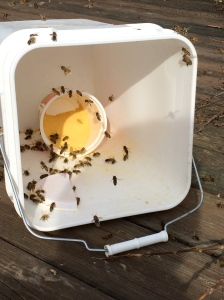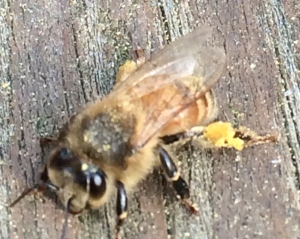For the beginning beekeeper
If you are planning to take up the fascinating hobby of beekeeping this spring, there are several things you need to do now. You must decide on the type of hive you will use to house your bees. Most beekeepers use the Langstroth type hive, but topbar and Warre hives are growing in popularity. Even if you chose the Langstroth hive, you still have further decision as to the hive width (8 or 10 frame) and the depth (deep, medium or shallow). With the Langstroth, you may chose to use foundation or not. If you will be using foundation, you may chose beeswax or plastic coated with beeswax foundation. Foundation has an imprint of the hexagonal cell base which bees use as a guide to build their comb. Bees of course can and do build comb with out a guide, but foundation guides the bees to build combs within a moveable frame. In Pennsylvania and many other places, combs that cannot be removed for disease inspection are illegal. Foundation is now available as small cell (4.9 mm) or regular (5.4mm) diameters. Some claim that small cell foundation helps the bees to control the pest, Varroa destructor.
In addition to choosing the type of hive, you must also choose the race or strain of bees. All the honey bees kept in North and South America are strains of Apis mellifera (the Western or European honey bee). However, there are several strains having differencing characteristics. I advise that you read about these various strains before choosing. Some strains may be difficult to obtain. Most beginners purchase either a package or a nuc (nucleus colony) to populate their new hive. The most common starting unit is a 3 pound package of bees that may be obtained from (usually) southern beekeepers. A package may be delivered either by mail or by a beekeeper that drives the packages north. Packages regularly sell out, so order now. A few nucs may be available from local beekeepers. Nucs are usually more expensive than a package, but have the benefit of more rapid development compared to a package.
While waiting for spring, it is essential that you prepare your chosen hive in advance of the arrival of your bees. Furthermore, you must educate your self on the science and art of beekeeping. I advise taking an introductory course on beekeeping that may be available locally or on-line. Additionally, read as much as possible about bees. Many books are available for purchase, and your local library may also have beekeeping books. A mentor is very valuable. Join a local beekeeping club and regularly attend meetings to meet beekeepers. Most beekeeper are willing to answer questions. Honey bee management is influenced by local conditions, and local beekeepers can offer local advice.
For the established beekeeper
If you plan on increasing the number of hives you manage, now is the time to act. Order and assemble all the equipment you will need. Even better, order some extra equipment to take advantage of an unexpectedly large honey crop or extra swarms!
There are many different ways to increase your numbers: swarms, packages, or splits, with or without purchased queens.
Swarms are wonderful, but they are a chance event and require time and effort. Thus, although swarms can be valuable for drawing new comb and/or producing comb honey, they cannot be relied on for increasing the number of hives. Because bees in a swarm may be carrying American Foul Brood (AFB) spores in their honey crop, swarms should always be hived without drawn comb. When hived on drawn comb, bees in a swarm will transfer their honey to the comb, including any AFB spores present, thus contaminating the comb. However, if the bees initially have no drawn comb, they will eat the contents of their honey crop and thereby digest the AFB spores. Hive a swarm on foundation, frames with a wax starter strip or foundationless frames.
Packages are a good way to increase your hive number, but your must place your order for packages now as the number of packages are limited. Hiving packages on foundation is recommended to reduce the risk of spreading AFB, as mentioned for swarms (above). Under ideal management, a package of bees will take 8 to 10 weeks to reach a population of 50,000 bees. This means that a package obtained on April 1, is unlikely to make surplus honey from a nectar flow that occurs in mid-May. However, a package may produce honey if later nectar flows are available in your area.
Making splits is usually a better way to increase hive number than buying packages, since a split will have brood to sustain the population during the time eggs laid by the new queen develop into adult bees. If you will be purchasing queens for your splits, place your orders now as queens for the early spring sell out quickly. It would be ideal if you could obtain a queen 6 weeks (or more) before the main nectar flow in your area. If you will be raising your own queens, you will have to wait until the spring weather allows colonies to produce sexually mature drones and queens. Remember that drones take approximately 24 days from egg to adult and then another approximately 14 days to become sexually mature (total about 38 days). In contrast, queens take only 16 days from egg to adult and then about a week to become sexually mature (total about 23 days). This means that colonies must start raising drones about 2 weeks before you can start raising queens. However, colonies will not raise drones until they have adequate food supply, especially of pollen. Furthermore, if pollen collection is interrupted due to cold and/or rainy weather, the mature drones may be kicked out of the colony, leaving the virgin queen without sufficient numbers of drones. To ensure an early supply of drones (and queen cells) feeding pollen or pollen substitute is recommended.


